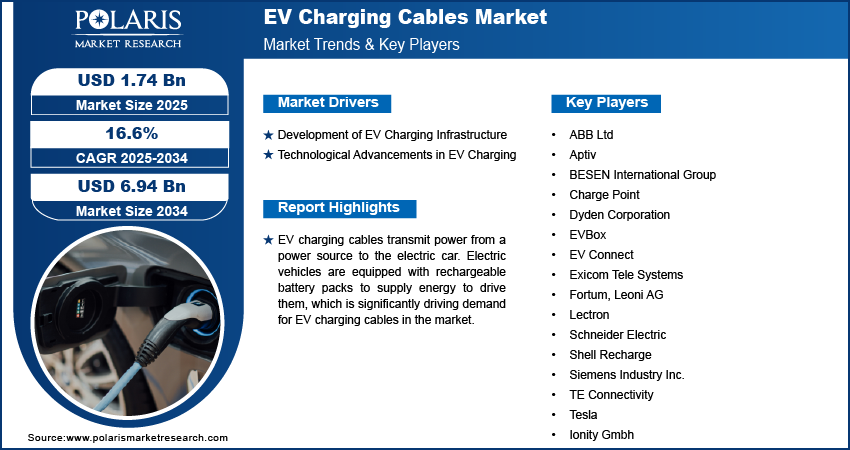The EV charging cables market is a rapidly expanding segment of the broader EV infrastructure industry. These cables are designed to ensure efficient and safe energy transfer while accommodating various charging speeds and vehicle types. With increasing investments in EV infrastructure and the rising adoption of electric vehicles, the demand for high-quality, durable, and efficient charging cables is growing significantly.
The EV charging cables market size is projected to grow from USD 1.74 billion in 2025 to USD 6.94 billion by 2034, exhibiting a CAGR of 16.6% from 2025 to 2034.
Market’s Growth Drivers
- Rising EV Adoption:
- The surge in electric vehicle sales, driven by environmental concerns and government policies, is a primary driver of the EV charging cables market.
- Government Incentives and Regulations:
- Subsidies, tax rebates, and stringent emission norms are encouraging consumers to switch to EVs, boosting the demand for charging infrastructure.
- Expansion of Charging Infrastructure:
- Investments in public and private charging networks are creating a robust demand for reliable and versatile charging cables.
- Technological Advancements:
- Innovations such as ultra-fast charging, wireless charging, and smart charging technologies are driving the need for advanced cables that can handle high power loads.
- Focus on Sustainability:
- The use of eco-friendly materials and recyclable components in cable production aligns with the global push for sustainable practices.
Key Trends
- High-Power Charging (HPC) Cables:
- The shift toward ultra-fast charging solutions requires cables capable of handling high power levels, often exceeding 350 kW.
- Liquid-Cooled Cables:
- To mitigate heat generation during high-power charging, manufacturers are developing liquid-cooled cables that ensure efficient thermal management.
- Portable Charging Solutions:
- The rise of portable EV chargers is driving demand for lightweight and flexible charging cables.
- Standardization and Interoperability:
- Efforts to standardize charging connectors (e.g., CCS, CHAdeMO, and Type 2) are simplifying the user experience and boosting market growth.
- Integration of IoT:
- Smart charging cables equipped with IoT capabilities allow real-time monitoring, diagnostics, and energy management.
Research Scope
The EV charging cables market offers a vast scope for research and development. Key areas of focus include:
- Material Innovations:
- Development of lightweight, durable, and heat-resistant materials to enhance cable performance.
- Safety Enhancements:
- Incorporating features such as overload protection, insulation monitoring, and fire resistance.
- Wireless Charging Compatibility:
- Exploring the integration of wired and wireless charging solutions for hybrid charging systems.
- Sustainability:
- Research into biodegradable and recyclable materials for cable production.
Market key Companies:
Understanding key players and their initiatives provides valuable insights into the competitive landscape and emerging opportunities in the market. Here are the top companies in the market:
- ABB Ltd
- Aptiv
- BESEN International Group
- Charge Point
- Dyden Corporation
- EVBox
- EV Connect
- Exicom Tele Systems
- Fortum
- Leoni AG
- Lectron
- Schneider Electric
- Shell Recharge
- Siemens Industry Inc.
- TE Connectivity
- Tesla
- Ionity Gmbh
Market Segmentation
The EV charging cables market is segmented based on several factors:
By Charging Level Outlook (Revenue – USD Billion, 2020–2034)
- Level 1
- Level 2
- Level 3
By Cable Length Outlook (Revenue – USD Billion, 2020–2034)
- Upto 5 meters
- 6 to 10 meters
- Above 10 meters
By Application Outlook (Revenue – USD Billion, 2020–2034)
- Public
- Private
By Power Supply Outlook (Revenue – USD Billion, 2020–2034)
- Alternate
- Direct
By Mode Outlook (Revenue – USD Billion, 2020–2034)
- Mode 1 & 2
- Mode 3
- Mode 4
By Shape Outlook (Revenue – USD Billion, 2020–2034)
- Straight
- Coiled
By Cable Type Outlook (Revenue – USD Billion, 2020–2034)
- Normal Charging Cable
- High Power Charging Cable
- Liquid Cooled High Power Charging Cable
By Jacket Material Outlook (Revenue – USD Billion, 2020–2034)
- All Rubber
- Thermoplastic Elastomer ( TPE)
- Polyvinyl Chloride(PVC)
By Connector Type Outlook (Revenue – USD Billion, 2020–2034)
- Type 1
- Type 2
- CCS 2
- CHADEMO
- GB/T
- NACS/Tesla
By Regional Outlook (Revenue – USD Billion, 2020–2034)
- North America
- Europe
- Asia Pacific
- Latin America
- Middle East & Africa
𝐂𝐥𝐢𝐜𝐤 𝐡𝐞𝐫𝐞 𝐭𝐨 𝐀𝐜𝐜𝐞𝐬𝐬 𝐭𝐡𝐞 𝐅𝐮𝐥𝐥 𝐑𝐞𝐩𝐨𝐫𝐭:
https://www.polarismarketresearch.com/industry-analysis/ev-charging-cables
The EV charging cables market is poised for remarkable growth, driven by the global shift toward electric mobility and sustainable energy solutions. As technology advances and infrastructure expands, the demand for innovative, efficient, and reliable charging cables will continue to surge. Companies and stakeholders in the EV ecosystem must focus on research, standardization, and sustainability to capitalize on the immense opportunities this market presents.
The EV charging cables market size is projected to grow from USD 1.74 billion in 2025 to USD 6.94 billion by 2034, exhibiting a CAGR of 16.6% from 2025 to 2034.

